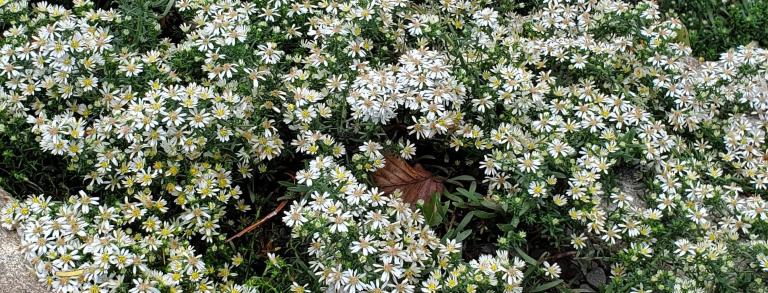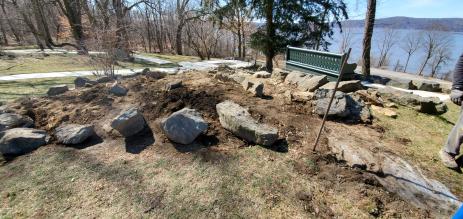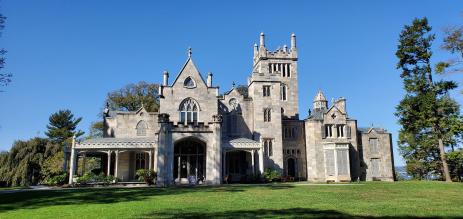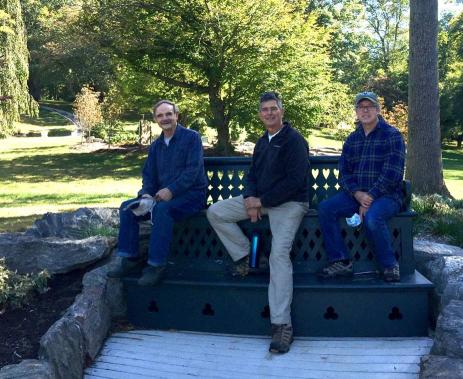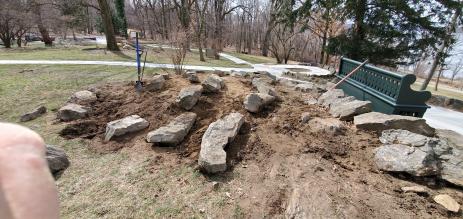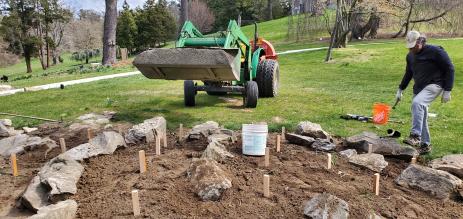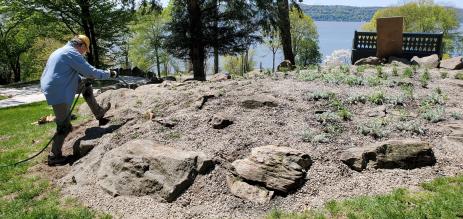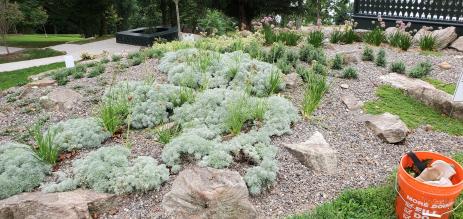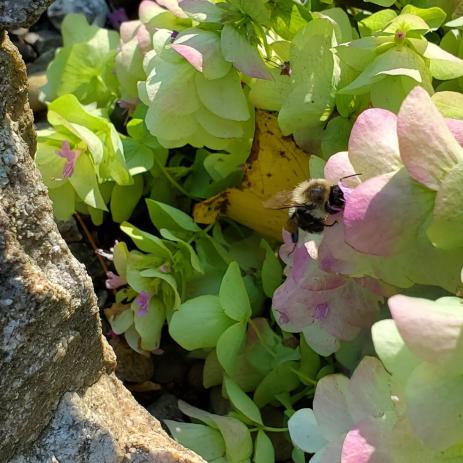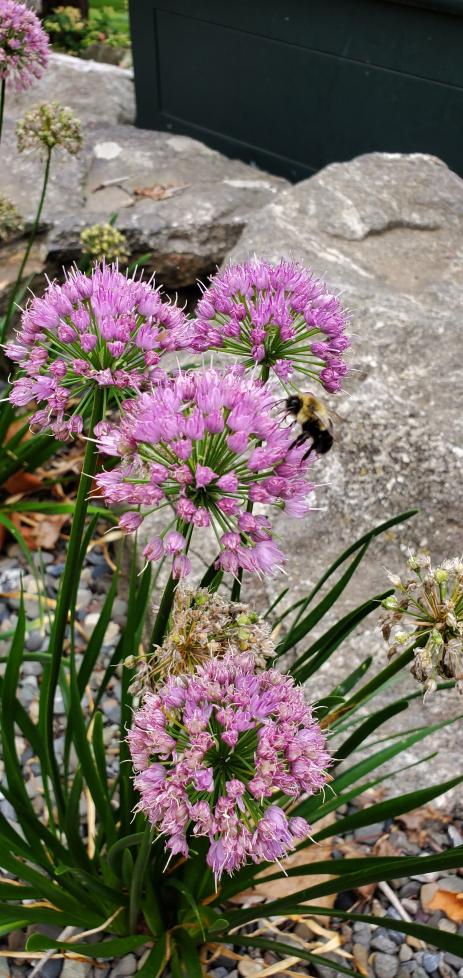SUPPOSE YOU WERE offered a site for a rock garden with a beautiful vista, a rock outcropping, and large boulders on the site? Who could pass that up? That is what Howard Zar, executive director of Lyndhurst in Tarrytown, New York, proposed to our group, the Hudson Valley Chapter of NARGS, in September 2019. One major problem was the deer herd on the property. But because of our long experience with the property, we felt we were up to the challenge. Even better, Lyndhurst would pay for the expenses.
The site was beautiful, with a view of the Hudson River at the wide spot called the Tappan Zee and in sight of the new Governor Mario Cuomo Bridge about 25 miles (40 km) north of New York City. A custom-made bench on one side of the site replicated one that had been there many years ago when a Victorian rockery was established amidst the outcropping and boulders.
The institution had originally had a landscape plan drawn up by a Vermont firm. Unfortunately, the plants selected included ones sure to be deer fodder, like Trillium grandiflorum, and others that just won’t grow here, like Cornus canadensis.
Our chapter has maintained a rock garden at Lyndhurst for 20 years. It was large, roughly 100 feet (30 m) long and 20 feet (6 m) wide. The site was adjacent to a patio where a café with tables brought visitors. Unfortunately, the café was discontinued and our garden was off the beaten path of visitor traffic. With few visitors, our crew, which consisted of longtime rock gardener Rick Plate; Mark Womack, a recent member; and myself, occasionally wondered about the purpose of our work.
The main attraction of Lyndhurst is the mansion constructed with limestone blocks in the Gothic Revival style in the 1800s. Also on the site is the iron frame of a large conservatory by Lord and Burnham that, at one time, was one of the largest in private hands. The extravagant Victorian cabinetry and trim of the interior lent itself to film shoots for the History Channel, and back in the 1960s, a vampire tale serialized daily called Dark Shadows was filmed there. (At one of our meetings, a stranger with a black cape walked in and announced that he was Barnaby, the main character.)
The rockery restoration was part of a development at Lyndhurst that aimed to create interest beyond the mansion itself. The proposed site was originally a Victorian rockery, which probably had typical garden plants, not alpines, with rocks. Recently, wide concrete walkways were built to connect to the rockery, another outcropping, and other features on the hillside that leads down to the Hudson River from the mansion. The idea was not to create a botanical garden but a park-like setting with horticultural highlights. A deer fence around the rockery was out of the picture financially and aesthetically, but our experience of coping with deer made us think we could create an interesting rock garden that was deer resistant. Deer are a big problem in our area.“Will deer eat it?” is the most common question asked at our plant sales. It is estimated that a herd of 35 deer lives on the 67 acres of Lyndhurst.
We needed to prepare the site, roughly 25 feet by 25 feet (7.6 m x 7.6 m), with several large boulders on the perimeter from the original rockery and other boulders that had been placed haphazardly on the site during the construction of the walkways. Mark, Rick, and I were able to lever and roll the movable boulders – 200 pounds (90 kg) and more – into a design that suited us.
We debated as diplomatically as we could where each boulder would go, and how it should be situated: a little this way or a little that way. Since the site was on an incline, it made sense to us to line up the movable boulders in a series of rough ledges as though several outcrops led down the slope. One of the hardest things to do is to position rocks in a way that looks random but also natural. We were able to do this during the mild winter months of January to March of 2020.
The existing soil on the site was heavy clay so we amended it with coarse sand, what is locally called concrete sand. We mixed some of this into the top of the existing soil and then aimed for a four- to five-inch (10 – 13 cm) layer of sand on top of that. A tractor with a scoop, driven by David Ware the grounds manager, was employed to bring the sand to our site. Rick made “story stakes” marked off in inches so we could judge if we were reaching the target depth of sand, which we then topped with three inches (7.6 cm) of half-inch (1.27 cm) gravel.
In general, deer will eat even “deer-resistant” plants if they are hungry enough, but there are a few plant characteristics that they do not favor. Prime among these are aromatic plants, especially herbs which seem to have their own built-in deer resistant spray. Also, the lower and tighter to the ground flowers are, the less tempting they are to deer.
Here are our choices which, after six months, have not even been browsed by deer. I am listing these roughly in order of flowering. We are hoping to have something in bloom through the season. We planted these in large, separate groups by type, rather than mixing the plants, to make more of a statement. Also, as Rick said, not to be too artsy, we left some negative space between the groupings.
Phlox ‘Herbert’ is the earliest to flower in March/April. Flowers are lavender/pink and at only one to two inches (2.5 – 5 cm) tall are too low for deer to bother with.
Thymus praecox ‘Coccineus’ has rosy-red flowers and is planted in crevices of the outcropping.
Veronica ‘Waterperry Blue’ has blue flowers in early summer, and becomes a four- to six-inch (10 to 15 cm) tall groundcover.
Allium cernuum has pink flowers and Allium ‘Millenium’ has rosy purple flowers that make a beautiful statement in the garden (thanks to NARGS member Mark McDonough for creating this hybrid.)
Geranium x cantabrigiense ‘Biokovo’ is a dwarf (8 inches/20 cm) geranium with very light pink flowers.
Artemisia schmidtiana ‘Silver Mound’ has shimmering silvery foliage and was very durable in our old rock garden, lasting 20 years.
Teucrium chamaedrys ‘Nanum’ is another long-lasting shrublet with rose flowers in summer.
Origanum rotundifolium ‘Kent Beauty’ is a standout adorned with hops-like bracts and lavender florets, growing 6 inches (15 cm) high.
Saponaria x lempergii ‘Max Frei’ is a cascading form of soapwort that has bloomed all summer and into fall.
Symphyotrichum ericoides is a ground-hugging western aster covered with white flowers in September and October.
Planting in deer country is quite a challenge, but one that many of us face, and we have found with the right plant choices we have been able to create a beautiful garden.

